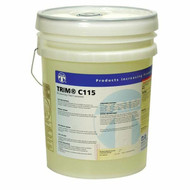Selecting and maintaining the right coolant for machining
Posted by All Industrial Tool Supply on Sep 30, 2021
Choosing the correct metalworking coolant for your machine can help control costs and increase efficiency, but there are so many options - which should you choose for the best performance? Let’s review your choices, with some input from some of the top coolant manufacturers.
What does coolant do while machining?
Used correctly, coolant performs four critical roles in a machine shop.
- Keeping tools cool
- Lubrication for the cutting process
- Clearing away chips
- Prevents rust / corrosion on both the workpiece and machine
Your coolant options largely fall into one of two types:
- Sulfur-based oil coolants
Sulfur-based oil coolants are used in machining operations in which very high cutting forces are present. Sulfur-based oil coolant is rare, expensive, and uncommon. - Water-based coolants
Water-based coolants are generally used for all other machining operations and are by far the most common coolants in use today. Water-based coolant can be more effective at removing heat compared with oil.
These water-based coolants are then further sub-divided into 3 categories:
- Soluble Oils
The most natural type of coolant often contains about 50% oil. It can be gentler on human skin, but requires maintenance or it can develop a bad smell, caused by bacteria growth. - Synthetics
These contain no oil and are commonly used in aerospace applications. They can be harsher on human skin due to their chemical makeup. - Semi-synthetics
Semi-synthetics combine soluble oils with synthetics, a mix of chemical compounds and mineral oils. They are less likely to develop a bad odor.
Potential cost savings
According to our partner Master Fluid Solutions, coolant costs can represent from 1-3% of your total manufacturing cost, so savings are possible in both the cost of the coolant selected itself, as well as in increased efficiencies - less wasted material and increased tool lifespan.
Master Fluid Solutions Synthetic Coolant in 5 gallon size
Factors to consider when choosing a coolant:
Top brands like Master Fluid Solutions and Kool Mist suggest you consider these important factors when selecting a coolant:
- Material - What are you cutting? Metal? Certain plastics and composites can react positively, or negatively, to specific coolants as well.
- Machines - what is required by the machine manufacturer?
- Operations - which operations are you performing?
- Tooling - what tools are being used?
- Water quality - is your water supply hard or soft?
- Operator contact - will humans be exposed to the coolant through skin or inhalation?
- Fluid restrictions - what’s approved for your industry?
- Foam - excessive foaming can increase the amount of coolant used and affect work quality.
- Filtration - how will you filter the coolant and the air?
- Coolant pressure on the machine.
Restrictions based on industry
Before selecting a coolant, ensure there are no industry-specific restrictions on your choice. For example, in aerospace, a manufacturer like Boeing or Airbus may need to provide specific approval for each coolant used.
Price is a factor - but not the only factor
Yes, a low cost-per-gallon can be appealing. If it only lasts half as long, however, an inexpensive coolant is no bargain. Higher quality coolant might be more expensive, but can pay off in tool life and reduced coolant consumption.
Check with your machine manufacturer
Each manufacturer will provide not only the type of coolant required, but often the specific concentration required as well. Concentration is determined by the coolant manufacturer and is listed as a range, i.e. 7-9%. Choose an appropriate coolant concentration that matches the machine and manufacturer requirements.
Why it’s important to monitor coolant
As time passes, coolant fluid can become contaminated. Regular testing will ensure your coolant:
- has the correct concentration of water-soluble fluids
- has the correct pH
- does not go rancid. Bacterial growth (commonly caused by using too low of a concentration) can cause coolant to go rancid.
What not to do
Don’t attempt to use water, alone, as a coolant. Doing so could promote corrosion.
Health Issues for machine operators
Coolant can be hard on your skin, sometimes leading to irritation or rashes. These problems are made worse if the coolant is dirty. In extreme cases, dirty coolant could cause an infection if it enters the skin through abrasions. Operators should avoid inhaling coolant when possible.
Call or write for a free audit
If you’re overwhelmed by the number of coolant options available, All Industrial Tool Supply can review your existing coolant plan and make recommendations to improve your efficiency. Get in touch for a free analysis of your needs.

 714.897.1700
714.897.1700
 Chat
Chat
 Email
Email
 844.548.0100
844.548.0100
 Quotes
Quotes
 Quick Order
Quick Order

